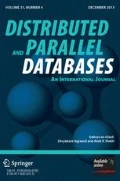Abstract
We study client-server caching of data with expiration timestamps. Although motivated by the potential for caching in telecommunication applications, our work extends to the general case of caching data that has known expiration times. Toward this end, we tailor caching algorithms to consider expiration timestamps. Next, we consider several different client-server paradigms that differ in whether and how the server updates client caches. Finally, we perform simulation studies to evaluate the empirical performance of a variety of strategies for managing a single cache independent of the server and for managing caches in a client-server setting.
Similar content being viewed by others
References
S. Acharya, M. Franklin, and S. Zdonik, “Balancing push and pull for data broadcast,” in Proceedings of the ACM SIGMOD Conference, May 1997, pp. 183–194.
C. Aggarwal, J. Wolf, and P. Yu, “Caching on the world wide web,” IEEE Transactions on Knowledge and Data Engineering, vol. 11, pp. 94–107, 1999.
L. Belady, “A study of replacement algorithms for virtual storage computers,” IBM Systems Journal, vol. 5, pp. 78–101, 1966.
L. Belady, R. Nelson, and G. Shedler, “An anomaly in space-time characteristics of certain programs running in a paging machine,” Communications of the ACM, vol. 12, pp. 349–353, 1969.
A. Borodin and R. El-Yaniv, Online Computation and Competitive Analysis, Cambridge University Press: Cambridge, UK, 1998.
P. Cao and C. Liu, “Maintaining strong cache consistency in the world wide web,” IEEE Transactions on Computers, vol. 47, pp. 445–457, 1998.
T. Carpenter, R. Carter, M. Cochinwala, M. Eiger, and M. Mihail, “Competitive analysis of client-server caching with expiration timestamps,” Working Paper, 1998.
CSIM 18 Users Guide, Mesquite Software, Inc., Austin, Texas, 1996.
C.R. Cunha, A. Bestavros, and M.E. Crovella, “Characteristics of WWW client-based traces,” Technical Report TR-95-010, Boston University, Computer Science Dept., 1995.
M. Franklin, Client Data Caching: A Foundation for High Performance Object Database Systems, Kluwer Academic Publishers: Boston, MA, 1996.
M. Franklin, M. Carey, and M. Livny, “Transactional client-server cache consistency: Alternatives and performance,” ACM Transactions on Database Systems, vol. 22, pp. 315–363, 1997.
S. Glassman, “A caching relay for the world wide web,” in Proceedings of the First International Conference on the World Wide Web, 1994.
J. Gwertzman and M. Seltzer, “World-wide web cache consistency,” in Proceedings of the 1996 USENIX Technical Conference, San Diego, California, April, 1996.
G. Herman, G. Gopal, K. Lee, and A. Weinrib, “The datacycle architecture for very high throughput database systems,” in Proceedings of ACM SIGMOD, ACM, New York, 1987.
A. Karlin, M. Manasse, L. Rudolph, and D. Sleator, “Competitive snoopy caching,” Algorithmica, vol. 3, pp. 79–119, 1988.
D. Knuth, The Art of Computer Programming, vol. 3, Addison Wesley: Reading, MA, 1973.
H. Korth and A. Silberschatz, Database Systems Concepts, McGraw-Hill Book Company: New York, 1986.
P. Mockapetris, “Domain names—concepts and facilities,” Internet Engineering Task Force RFC-1034, Nov. 1987.
P. Mockapetris, “Domain names—implementation and specification,” Internet Engineering Task Force RFC-1035, Nov. 1987.
E. O'Neil, P. O'Neil, and G. Weikum, “The LRU-K page replacement algorithm for database disk buffering,” in Proceedings of ACM SIGMOD, May 1993, pp. 297–306.
Author information
Authors and Affiliations
Rights and permissions
About this article
Cite this article
Carpenter, T., Carter, R., Cochinwala, M. et al. Client-Server Caching with Expiration Timestamps. Distributed and Parallel Databases 10, 5–22 (2001). https://doi.org/10.1023/A:1019248721089
Issue Date:
DOI: https://doi.org/10.1023/A:1019248721089




